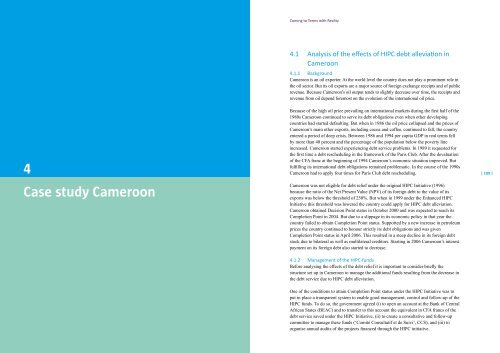Coming to Terms with Reality. Evaluation of the Belgian Debt Relief ...
Coming to Terms with Reality. Evaluation of the Belgian Debt Relief ...
Coming to Terms with Reality. Evaluation of the Belgian Debt Relief ...
Create successful ePaper yourself
Turn your PDF publications into a flip-book with our unique Google optimized e-Paper software.
4<br />
Case study Cameroon<br />
<strong>Coming</strong> <strong>to</strong> <strong>Terms</strong> <strong>with</strong> <strong>Reality</strong><br />
4.1 Analysis <strong>of</strong> <strong>the</strong> effects <strong>of</strong> HIPC debt alleviation in<br />
Cameroon<br />
4.1.1 Background<br />
Cameroon is an oil exporter. At <strong>the</strong> world level <strong>the</strong> country does not play a prominent role in<br />
<strong>the</strong> oil sec<strong>to</strong>r. But its oil exports are a major source <strong>of</strong> foreign exchange receipts and <strong>of</strong> public<br />
revenue. Because Cameroon’s oil output tends <strong>to</strong> slightly decrease over time, <strong>the</strong> receipts and<br />
revenue from oil depend foremost on <strong>the</strong> evolution <strong>of</strong> <strong>the</strong> international oil price.<br />
Because <strong>of</strong> <strong>the</strong> high oil price prevailing on international markets during <strong>the</strong> first half <strong>of</strong> <strong>the</strong><br />
1980s Cameroon continued <strong>to</strong> serve its debt obligations even when o<strong>the</strong>r developing<br />
countries had started defaulting. But when in 1986 <strong>the</strong> oil price collapsed and <strong>the</strong> prices <strong>of</strong><br />
Cameroon’s main o<strong>the</strong>r exports, including cocoa and c<strong>of</strong>fee, continued <strong>to</strong> fall, <strong>the</strong> country<br />
entered a period <strong>of</strong> deep crisis. Between 1986 and 1994 per capita GDP in real terms fell<br />
by more than 40 percent and <strong>the</strong> percentage <strong>of</strong> <strong>the</strong> population below <strong>the</strong> poverty line<br />
increased. Cameroon started experiencing debt service problems. In 1989 it requested for<br />
<strong>the</strong> first time a debt rescheduling in <strong>the</strong> framework <strong>of</strong> <strong>the</strong> Paris Club. After <strong>the</strong> devaluation<br />
<strong>of</strong> <strong>the</strong> CFA franc at <strong>the</strong> beginning <strong>of</strong> 1994 Cameroon’s economic situation improved. But<br />
fulfilling its international debt obligations remained problematic. In <strong>the</strong> course <strong>of</strong> <strong>the</strong> 1990s<br />
Cameroon had <strong>to</strong> apply four times for Paris Club debt rescheduling.<br />
Cameroon was not eligible for debt relief under <strong>the</strong> original HIPC Initiative (1996)<br />
because <strong>the</strong> ratio <strong>of</strong> <strong>the</strong> Net Present Value (NPV) <strong>of</strong> its foreign debt <strong>to</strong> <strong>the</strong> value <strong>of</strong> its<br />
exports was below <strong>the</strong> threshold <strong>of</strong> 250%. But when in 1999 under <strong>the</strong> Enhanced HIPC<br />
Initiative this threshold was lowered <strong>the</strong> country could apply for HIPC debt alleviation.<br />
Cameroon obtained Decision Point status in Oc<strong>to</strong>ber 2000 and was expected <strong>to</strong> reach its<br />
Completion Point in 2004. But due <strong>to</strong> a slippage in its economic policy in that year <strong>the</strong><br />
country failed <strong>to</strong> obtain Completion Point status. Supported by a new increase in petroleum<br />
prices <strong>the</strong> country continued <strong>to</strong> honour strictly its debt obligations and was given<br />
Completion Point status in April 2006. This resulted in a steep decline in its foreign debt<br />
s<strong>to</strong>ck due <strong>to</strong> bilateral as well as multilateral credi<strong>to</strong>rs. Starting in 2006 Cameroon’s interest<br />
payment on its foreign debt also started <strong>to</strong> decrease.<br />
4.1.2 Management <strong>of</strong> <strong>the</strong> HIPC-funds<br />
Before analysing <strong>the</strong> effects <strong>of</strong> <strong>the</strong> debt relief it is important <strong>to</strong> consider briefly <strong>the</strong><br />
structure set up in Cameroon <strong>to</strong> manage <strong>the</strong> additional funds resulting from <strong>the</strong> decrease in<br />
<strong>the</strong> debt service due <strong>to</strong> HIPC debt alleviation.<br />
One <strong>of</strong> <strong>the</strong> conditions <strong>to</strong> attain Completion Point status under <strong>the</strong> HIPC Initiative was <strong>to</strong><br />
put in place a transparent system <strong>to</strong> enable good management, control and follow-up <strong>of</strong> <strong>the</strong><br />
HIPC funds. To do so, <strong>the</strong> government agreed (i) <strong>to</strong> open an account at <strong>the</strong> Bank <strong>of</strong> Central<br />
African States (BEAC) and <strong>to</strong> transfer <strong>to</strong> this account <strong>the</strong> equivalent in CFA francs <strong>of</strong> <strong>the</strong><br />
debt service saved under <strong>the</strong> HIPC Initiative, (ii) <strong>to</strong> create a consultative and follow-up<br />
committee <strong>to</strong> manage <strong>the</strong>se funds (‘Comité Consultatif et de Suivi’, CCS), and (iii) <strong>to</strong><br />
organise annual audits <strong>of</strong> <strong>the</strong> projects financed through <strong>the</strong> HIPC initiative.<br />
| 109 |

















